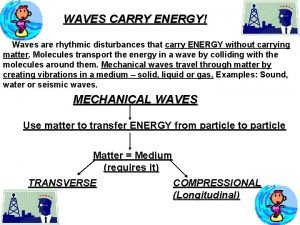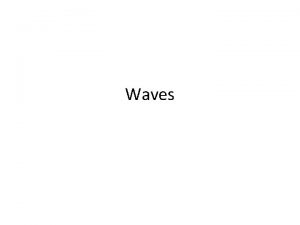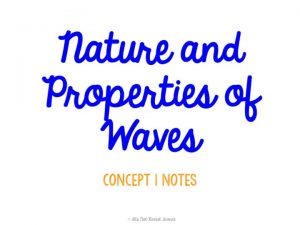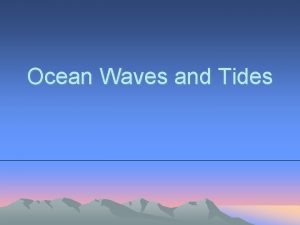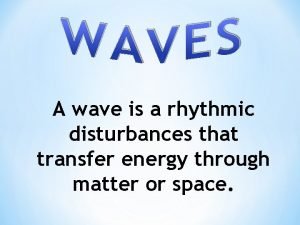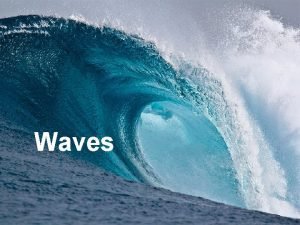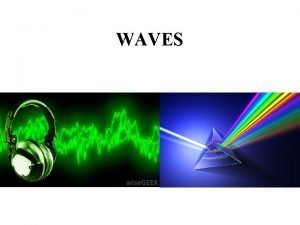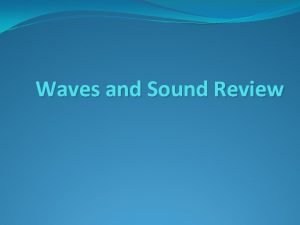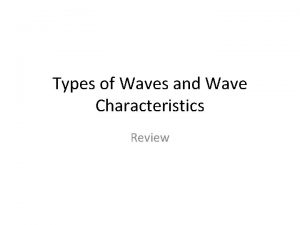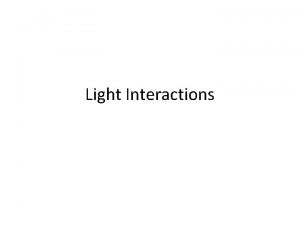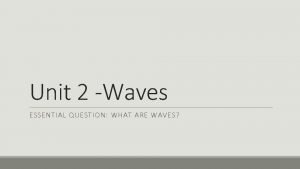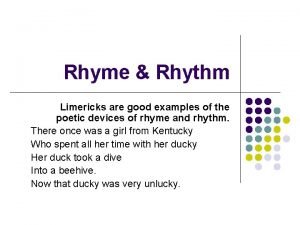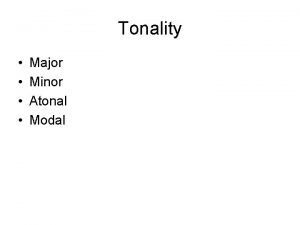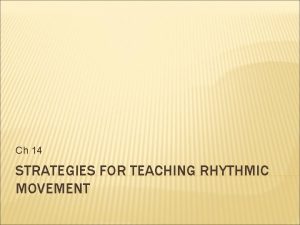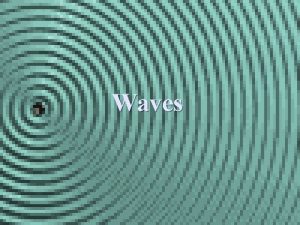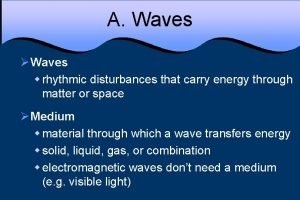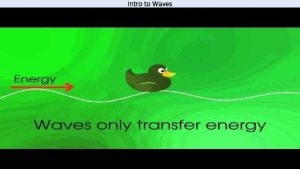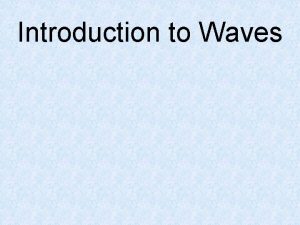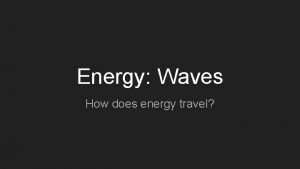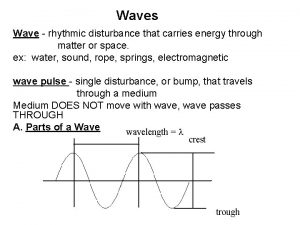WAVES How does energy travel Waves Waves rhythmic





















- Slides: 21

WAVES How does energy travel?

Waves • Waves – rhythmic disturbances (vibrations) that transfer energy through matter or space – carry energy from one place to another Very disturbing!

Waves Water Waves • How does the video display what a wave is? – Transfers energy from water to people

Waves Tuning Fork Demo • How does the demo display what a wave is? • Transfers energy from fork to water

Waves Earthquake • How does the video of an earthquake in Japan display what a wave is? • Transfers energy from seismic wave in earth (earthquake) to building

Classes of Waves • One way to distinguish between different waves is by what they move through or their medium – Medium: material through which a wave transfers energy • solid, liquid, gas, or combination • some waves require no medium • Types of waves based on medium: – mechanical waves – electromagnetic waves

Mechanical Waves • Mechanical waves: – waves that require a medium – particles of the medium must vibrate in order for energy to be transferred – Examples: • Water waves • Sound waves • Seismic waves (earthquakes)

Electromagnetic Waves • Electromagnetic waves: – waves that do not require a medium – can travel through empty space or matter • Empty space: where matter isn’t present – Examples: • • radio waves microwaves infrared waves visible light ultraviolet waves X-rays Gamma rays

More Classes of Waves • Not all waves transfer energy the same way • Waves can be classified by comparing the direction of particles in the medium to move with the direction in which the wave moves. • Two classes of waves: – Transverse – Longitudinal

Making Waves With your group members, try to make each class of waves using the provided slinky – Transverse – Longitudinal

Slinky Wave Lab With a partner you will discover some more about energy waves!

Slinky Wave Lab Conclusions • 1. ) What moves down the slinky as the wave propagates (propagates means ‘moves forward’)? – Energy • 2. ) According to the law of conservation of energy, energy cannot be created or destroyed. If so, what is the source of energy that created the wave in this lab? – Your hand (mechanical energy) • 3. ) Once the energy enters the slinky at your hand, where does it go? – Down the slinky to the other person

Slinky Wave Lab Conclusions If the energy is moving from your hand to the slinky from one end of it to the other 4. ) In what direction does the medium (look at piece of tape) move compared to the energy of the wave in a transverse wave? Perpendicular to (90 degree angle) 5. ). . . Longitudinal wave? Parallel to (same direction)

Slinky Wave Lab Conclusions 6. ) What can we conclude about the speed of a wave when you change the size of the pulse? The speed of a wave stays the same regardless of the size of the pulse 7. ) What factor do you think could affect the speed of a wave? The medium

Slinky Wave Lab Conclusions 8. ) What happens to the number of waves between two points when you increase the rate of pulses? More waves 9. ) What happens to the width of the waves between two points when you increase the rate of the pulses The width decreases

Transverse Wave of People • The entire class will form a transverse pulse. Stand shoulder to shoulder in a straight line. Create a stadium wave. – When the pulse travels through you, which way did you move? – How does this compare to the transverse wave of the slinky?

Transverse Waves • Transverse waves: – a wave in which the medium moves perpendicular to the direction of wave motion – examples: electromagnetic waves, strings on an instrument, some seismic waves

Anatomy of a Transverse Waves • Crest- highest point of transverse wave • Trough- lowest point of transverse wave • Wavelength- distance from one point on a wave to the corresponding point on the next wave

Longitudinal Wave of People • The entire class will form a longitudinal wave. Line up in a single file. Place your hands on the shoulders of the person in front of you. The person at the back of the line will send some energy to the person at the front of the line by nudging the person in front of them. When the pulse travels through you, which way do you move? – When the pulse travels through you, which way did you move? – How does this compare to the longitudinal wave of the slinky?

Longitudinal Waves • Longitudinal waves: – a wave in which the particles of medium vibrate back in forth in the same direction as (parallel to) the wave – also called compressional waves – Examples: Sound, some seismic waves

Anatomy of a Longitudinal Waves • Compression- Where the particles of the medium are close together (more dense) • Rarefaction- Where the particles of the medium are further apart (less dense) compression wavelength rarefaction wavelength
 Wave behavior
Wave behavior Waves are rhythmic disturbances that carry
Waves are rhythmic disturbances that carry Disturbance in waves
Disturbance in waves Examples of mechanical wave
Examples of mechanical wave Rhythmic disturbance that carries energy
Rhythmic disturbance that carries energy Rhythmic movement that carries energy through matter
Rhythmic movement that carries energy through matter A rhythmic disturbance that transfers energy
A rhythmic disturbance that transfers energy A rhythmic disturbance that carries energy in motion
A rhythmic disturbance that carries energy in motion Repeating disturbances that transfer energy through
Repeating disturbances that transfer energy through Energy energy transfer and general energy analysis
Energy energy transfer and general energy analysis Energy energy transfer and general energy analysis
Energy energy transfer and general energy analysis Light and sound travel in waves true or false
Light and sound travel in waves true or false Three waves a b and c travel 12 meters in 2.0 seconds
Three waves a b and c travel 12 meters in 2.0 seconds Sound waves from a radio generally travel in which medium
Sound waves from a radio generally travel in which medium Light interactions
Light interactions Do all em waves travel at the speed of light
Do all em waves travel at the speed of light Em waves can travel without
Em waves can travel without Poems with rhythm examples
Poems with rhythm examples Rhythmic building blocks
Rhythmic building blocks A verse and rhythmic writing with imagery that evokes
A verse and rhythmic writing with imagery that evokes Sustained translatory technique
Sustained translatory technique Rhythmic devices
Rhythmic devices

